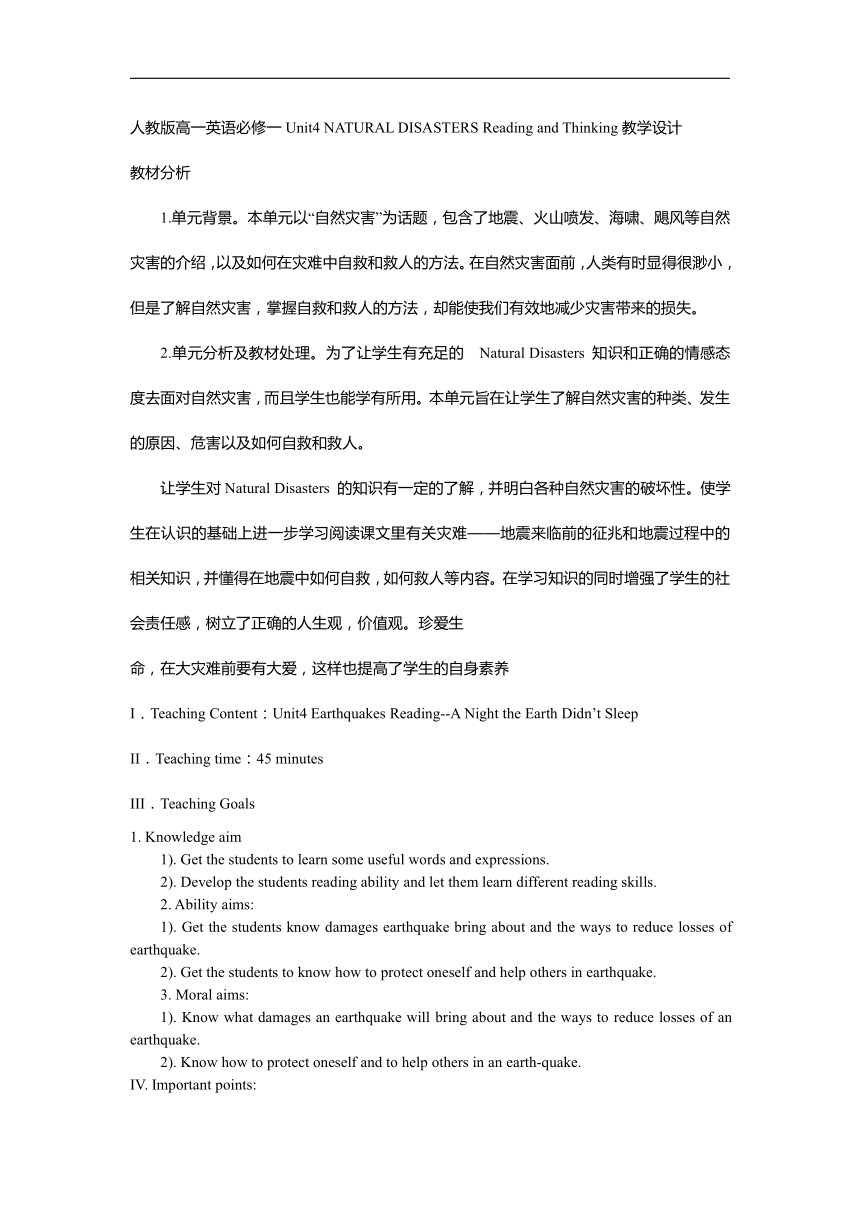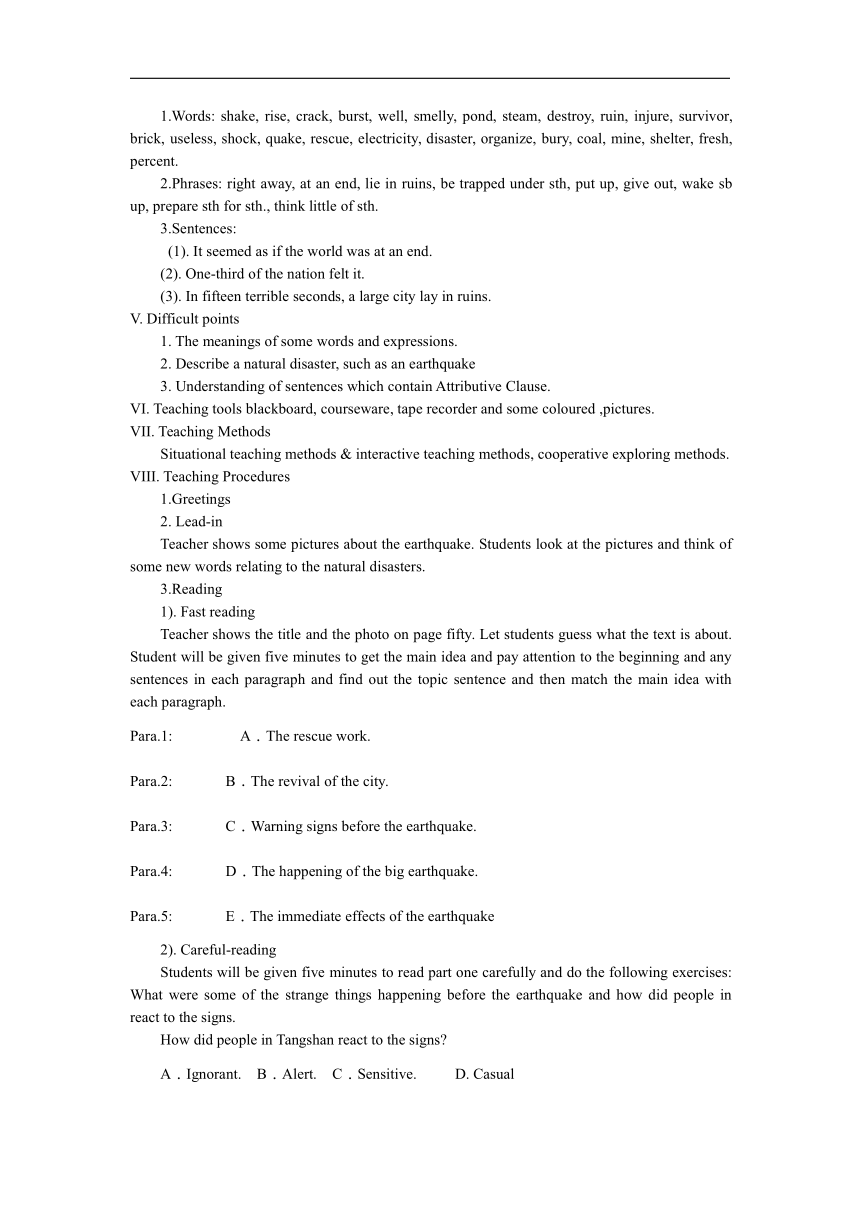人教版(2019)必修第一册Unit4 Natural Disasters Reading and thinking 教学设计
文档属性
| 名称 | 人教版(2019)必修第一册Unit4 Natural Disasters Reading and thinking 教学设计 |

|
|
| 格式 | docx | ||
| 文件大小 | 202.8KB | ||
| 资源类型 | 教案 | ||
| 版本资源 | 人教版(2019) | ||
| 科目 | 英语 | ||
| 更新时间 | 2024-04-05 15:51:02 | ||
图片预览


文档简介
人教版高一英语必修一Unit4 NATURAL DISASTERS Reading and Thinking教学设计
教材分析
1.单元背景。本单元以“自然灾害”为话题,包含了地震、火山喷发、海啸、飓风等自然灾害的介绍,以及如何在灾难中自救和救人的方法。在自然灾害面前,人类有时显得很渺小,但是了解自然灾害,掌握自救和救人的方法,却能使我们有效地减少灾害带来的损失。
2.单元分析及教材处理。为了让学生有充足的 Natural Disasters 知识和正确的情感态度去面对自然灾害,而且学生也能学有所用。本单元旨在让学生了解自然灾害的种类、发生的原因、危害以及如何自救和救人。
让学生对Natural Disasters 的知识有一定的了解,并明白各种自然灾害的破坏性。使学生在认识的基础上进一步学习阅读课文里有关灾难——地震来临前的征兆和地震过程中的相关知识,并懂得在地震中如何自救,如何救人等内容。在学习知识的同时增强了学生的社会责任感,树立了正确的人生观,价值观。珍爱生
命,在大灾难前要有大爱,这样也提高了学生的自身素养
I.Teaching Content:Unit4 Earthquakes Reading--A Night the Earth Didn’t Sleep
II.Teaching time:45 minutes
III.Teaching Goals
1. Knowledge aim
1). Get the students to learn some useful words and expressions.
2). Develop the students reading ability and let them learn different reading skills.
2. Ability aims:
1). Get the students know damages earthquake bring about and the ways to reduce losses of earthquake.
2). Get the students to know how to protect oneself and help others in earthquake.
3. Moral aims:
1). Know what damages an earthquake will bring about and the ways to reduce losses of an earthquake.
2). Know how to protect oneself and to help others in an earth-quake.
IV. Important points:
1.Words: shake, rise, crack, burst, well, smelly, pond, steam, destroy, ruin, injure, survivor, brick, useless, shock, quake, rescue, electricity, disaster, organize, bury, coal, mine, shelter, fresh, percent.
2.Phrases: right away, at an end, lie in ruins, be trapped under sth, put up, give out, wake sb up, prepare sth for sth., think little of sth.
3.Sentences:
(1). It seemed as if the world was at an end.
(2). One-third of the nation felt it.
(3). In fifteen terrible seconds, a large city lay in ruins.
V. Difficult points
1. The meanings of some words and expressions.
2. Describe a natural disaster, such as an earthquake
3. Understanding of sentences which contain Attributive Clause.
VI. Teaching tools blackboard, courseware, tape recorder and some coloured ,pictures.
VII. Teaching Methods
Situational teaching methods & interactive teaching methods, cooperative exploring methods.
VIII. Teaching Procedures
1.Greetings
2. Lead-in
Teacher shows some pictures about the earthquake. Students look at the pictures and think of some new words relating to the natural disasters.
3.Reading
1). Fast reading
Teacher shows the title and the photo on page fifty. Let students guess what the text is about. Student will be given five minutes to get the main idea and pay attention to the beginning and any sentences in each paragraph and find out the topic sentence and then match the main idea with each paragraph.
Para.1: A.The rescue work.
Para.2: B.The revival of the city.
Para.3: C.Warning signs before the earthquake.
Para.4: D.The happening of the big earthquake.
Para.5: E.The immediate effects of the earthquake
2). Careful-reading
Students will be given five minutes to read part one carefully and do the following exercises: What were some of the strange things happening before the earthquake and how did people in react to the signs.
How did people in Tangshan react to the signs
A.Ignorant. B.Alert. C.Sensitive. D. Casual
3. What rhetorical device(修辞手法) does the author use in the sentence “the water in the village wells rose and fell, rose and fell”?
A.Metaphor(比喻).B.Repetition(重复).
C.Parallelism(排比).D.Personification(拟人).
参考答案 A A
Function: To make the description more vivid and involve the readers in the atmosphere.
Students read part 2 carefully and do the following exercise and read paragraph 3 to carefully to do the following exercise the teacher will choose some students to show your answers for others
1. How can we protect ourselves in an earthquake at school?
2.What can you do after an earthquake
(Creative thinking)
Post-reading
Groupwork
(1) Don’t be nervous and keep calm.
(2) Don’t try to run out of the classroom.
(3) Sit down under your desk.
(4) Protect your head by putting your bag on your head.
(5) Don’t use lift.
(6)If possible,run to the schoolyard.
IX. Group work
Students will be given five minutes to have a group of work to have a discussion about how can we protect ourselves in an earthquake at school and what can you do after an earthquake What do you think helped in the revival of city
What lesson can we learn from these events Some students will be invited to share their answers for the other students.
The spirit of combating disaster relief抗震救灾精神
Whether in Tangshan earthquake or in Wenchuan earthquake, the most important thing is the spirit of Chinese people. Every time a disaster happens, we fight against it together and we never lose hope. That is the spirit of combating disaster relief
Recently, in the battle against COVID-19, China did the best in controlling the virus. That is the result of the spirit of combating COVID-19
X. Summary
Some students will be invited to have a summary about what did we learn today.
XI. Homework
1.Write a passage about your feelings after today’s passage learning.
2.Finish activity 5.
XII. Blackboard writing
XIII. Teaching reflection
课后反思
依据教学目标,对学生的学习过程进行评价,旨在反思教学效果,不断改进自己的教学方法与策略。在本节阅读课中,通过教学目标为引导,对学生在学习过程中的表现进行评价,旨在提高教学效果,不断优化教学方法。在本次阅读课中,我采取了多种手段来帮助学生理解文章内容。在各个环节中,我注重培养学生的阅读技巧和阅读策略,例如通过略读和扫读来获取文章主旨和细节信息,通过推断和猜测词义来理解文章中的生词和难句。虽然大部分学生能够积极参与课堂活动,但是对于文章中出现的生词和难句还是存在理解上的困难。在今后的教学中,我应该更加关注学生的阅读能力和基础知识,通过多种方式来提高学生的阅读速度和理解能力,以帮助他们更好地理解和掌握文章内容。
教材分析
1.单元背景。本单元以“自然灾害”为话题,包含了地震、火山喷发、海啸、飓风等自然灾害的介绍,以及如何在灾难中自救和救人的方法。在自然灾害面前,人类有时显得很渺小,但是了解自然灾害,掌握自救和救人的方法,却能使我们有效地减少灾害带来的损失。
2.单元分析及教材处理。为了让学生有充足的 Natural Disasters 知识和正确的情感态度去面对自然灾害,而且学生也能学有所用。本单元旨在让学生了解自然灾害的种类、发生的原因、危害以及如何自救和救人。
让学生对Natural Disasters 的知识有一定的了解,并明白各种自然灾害的破坏性。使学生在认识的基础上进一步学习阅读课文里有关灾难——地震来临前的征兆和地震过程中的相关知识,并懂得在地震中如何自救,如何救人等内容。在学习知识的同时增强了学生的社会责任感,树立了正确的人生观,价值观。珍爱生
命,在大灾难前要有大爱,这样也提高了学生的自身素养
I.Teaching Content:Unit4 Earthquakes Reading--A Night the Earth Didn’t Sleep
II.Teaching time:45 minutes
III.Teaching Goals
1. Knowledge aim
1). Get the students to learn some useful words and expressions.
2). Develop the students reading ability and let them learn different reading skills.
2. Ability aims:
1). Get the students know damages earthquake bring about and the ways to reduce losses of earthquake.
2). Get the students to know how to protect oneself and help others in earthquake.
3. Moral aims:
1). Know what damages an earthquake will bring about and the ways to reduce losses of an earthquake.
2). Know how to protect oneself and to help others in an earth-quake.
IV. Important points:
1.Words: shake, rise, crack, burst, well, smelly, pond, steam, destroy, ruin, injure, survivor, brick, useless, shock, quake, rescue, electricity, disaster, organize, bury, coal, mine, shelter, fresh, percent.
2.Phrases: right away, at an end, lie in ruins, be trapped under sth, put up, give out, wake sb up, prepare sth for sth., think little of sth.
3.Sentences:
(1). It seemed as if the world was at an end.
(2). One-third of the nation felt it.
(3). In fifteen terrible seconds, a large city lay in ruins.
V. Difficult points
1. The meanings of some words and expressions.
2. Describe a natural disaster, such as an earthquake
3. Understanding of sentences which contain Attributive Clause.
VI. Teaching tools blackboard, courseware, tape recorder and some coloured ,pictures.
VII. Teaching Methods
Situational teaching methods & interactive teaching methods, cooperative exploring methods.
VIII. Teaching Procedures
1.Greetings
2. Lead-in
Teacher shows some pictures about the earthquake. Students look at the pictures and think of some new words relating to the natural disasters.
3.Reading
1). Fast reading
Teacher shows the title and the photo on page fifty. Let students guess what the text is about. Student will be given five minutes to get the main idea and pay attention to the beginning and any sentences in each paragraph and find out the topic sentence and then match the main idea with each paragraph.
Para.1: A.The rescue work.
Para.2: B.The revival of the city.
Para.3: C.Warning signs before the earthquake.
Para.4: D.The happening of the big earthquake.
Para.5: E.The immediate effects of the earthquake
2). Careful-reading
Students will be given five minutes to read part one carefully and do the following exercises: What were some of the strange things happening before the earthquake and how did people in react to the signs.
How did people in Tangshan react to the signs
A.Ignorant. B.Alert. C.Sensitive. D. Casual
3. What rhetorical device(修辞手法) does the author use in the sentence “the water in the village wells rose and fell, rose and fell”?
A.Metaphor(比喻).B.Repetition(重复).
C.Parallelism(排比).D.Personification(拟人).
参考答案 A A
Function: To make the description more vivid and involve the readers in the atmosphere.
Students read part 2 carefully and do the following exercise and read paragraph 3 to carefully to do the following exercise the teacher will choose some students to show your answers for others
1. How can we protect ourselves in an earthquake at school?
2.What can you do after an earthquake
(Creative thinking)
Post-reading
Groupwork
(1) Don’t be nervous and keep calm.
(2) Don’t try to run out of the classroom.
(3) Sit down under your desk.
(4) Protect your head by putting your bag on your head.
(5) Don’t use lift.
(6)If possible,run to the schoolyard.
IX. Group work
Students will be given five minutes to have a group of work to have a discussion about how can we protect ourselves in an earthquake at school and what can you do after an earthquake What do you think helped in the revival of city
What lesson can we learn from these events Some students will be invited to share their answers for the other students.
The spirit of combating disaster relief抗震救灾精神
Whether in Tangshan earthquake or in Wenchuan earthquake, the most important thing is the spirit of Chinese people. Every time a disaster happens, we fight against it together and we never lose hope. That is the spirit of combating disaster relief
Recently, in the battle against COVID-19, China did the best in controlling the virus. That is the result of the spirit of combating COVID-19
X. Summary
Some students will be invited to have a summary about what did we learn today.
XI. Homework
1.Write a passage about your feelings after today’s passage learning.
2.Finish activity 5.
XII. Blackboard writing
XIII. Teaching reflection
课后反思
依据教学目标,对学生的学习过程进行评价,旨在反思教学效果,不断改进自己的教学方法与策略。在本节阅读课中,通过教学目标为引导,对学生在学习过程中的表现进行评价,旨在提高教学效果,不断优化教学方法。在本次阅读课中,我采取了多种手段来帮助学生理解文章内容。在各个环节中,我注重培养学生的阅读技巧和阅读策略,例如通过略读和扫读来获取文章主旨和细节信息,通过推断和猜测词义来理解文章中的生词和难句。虽然大部分学生能够积极参与课堂活动,但是对于文章中出现的生词和难句还是存在理解上的困难。在今后的教学中,我应该更加关注学生的阅读能力和基础知识,通过多种方式来提高学生的阅读速度和理解能力,以帮助他们更好地理解和掌握文章内容。
